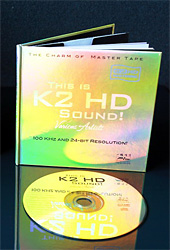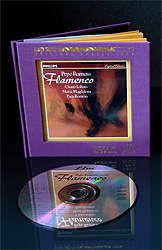
|
THIS IS K2 HD SOUND!
 Track listing: Rachmaninoff: Sym. Dance No. 1, excerpt Pepe Romero / Zapateado, excerpts Jian Jianhua / Left Alone Respighi: Queen of Sheba Suite: War Dance Christopher Hardy / Touch Lift Your Veil / A Rose for Me Tchaikovsky: Swan Lake Duo Nah Youn Sun / Heart of Glass Bruce Stark / Blue Dream Star Dust - Hot Club of SF Vivaldi / Four Seasons: Spring Wei Li / Amazing Grace Esther / Kinderpiele Habanera Fantasia from Carmen Tsuyoshi Yamamoto / Autumn in Seattle Pachelbel / Canon in D Publisher: various/First Impression Music, FIM K2 HD 078 Details: sampler K2 HD Date of issue: 01.10.2007 Format: K2 HD CD Sound quality: REFERENCE PEPE ROMERO
FLAMENCO  Track listing: 1.Farrucas 2. Zapateado 3. Aquellos duros antiguos(Tauguillos) 4. Soleares 5. HaEntrao una fragata(Alegrias) 6. Bulerias 7. De mi vera te fuistes(Seguiriyas) 8. Alegrias 9. Sera el quererte(Sevillanas corraleras) 10.Mama yo quiero un lucera (Bulerias) 11.Fue,porque non me dio ganas (Granadians) 12.Y sino, me daba doble (Cantirias) 13.Que se ven desde el Conquero (Fandangos de Huelva) Performers: Pepe Romero – guitar Chano Lobato – kanto Maria Magdalena – dance Paco Romero – dance Publisher: Philips/First Impression Music, LIM K2HD 022 Details: K2 HD recording, re-edition of the Digital Classic series, original recording DDD Date of issue (original/re-edition): 1988/01.12.2007 Format: K2 HD CD Sound quality: REFERENCE I will review those two discs together, because they are bound together in some way – one of them is a sampler showing the capabilities of the new technology, and the second a complete realization of the idea. And it is all about the K2 HD (High Definition).
Just like in the case of XRCD, the idea of K2 came from JVC studios. The main assumption was to discard the new standards (DVD-A and SACD) and concentrate on refining the mature, existing standard of the Compact Disc in a way, that every owner of a CD player would benefit from it, and not only the owners of hi-res players. It was also assumed, that the Red Book standard still has unused capabilities. And so, already in 1987 the scientific group developed the K2 system, a kind of an interface, that allows to increase the resolution of a CD. The system was named K2, because the names of the main engineers begun with the letter K: Kuwaoka and Kanai. In the year 1993 the system was improved in a way, that the sound coded by 20 bits converters retained such resolution. The company materials state, that real breakthrough came in 1996, when the first XRCD discs appeared. Its improvements: XRCD2 – 1998 and XRCD24 – 2002. 2004 was the year that the first recordings with the new system K2 appeared, having the resolution of 24 bits and the 100kHz frequency response, that was named K2 HD. After testing, JVC decided to license broadly the system, and start the sales of the first titles in 2007. To achieve this, a special team in the Flair Studio was founded, to develop the K2 HD mastering process. The young sound engineer Takeshi “Hakkaman” Hakmata became the chief of the sound technicians. The first licensee was the company FIM. The comparison of the new recordings was eased, because Mr. Ma supplies us with his disks for some time now. So I had recordings available for comparison made in HDCD (Super 24 bits) from the disc Audiophile Reference IV (review HERE), Five Songbirds (review HERE) and XRCD24 Super Sounds! II (review HERE) i Grooving Classic (FIM XR24 044), all of very good quality. A few listening sessions, especially with HDCD, and we know, that the new technology kicks butt of the older ones. This is not a subtle improvement, but a big step forward, just like it was promised. In short, the K2 HD sounds incredibly analog. Because the analog is the unrivaled exemplar for the digit. And in this matter, the new technology presents a much more smooth and fluent sound. Comparing to former recordings we have a mighty breath and refinement. Listening to Autumn In Seattle Tsuyoshi Yamamoto first from XRCD24, and then from K2 HD the digital nervousness and asperity disappear immediately. Yes, even a such refined realization like the mentioned one. This happens when changing this way, because when going back to XRCD24 from K2 HD we are immediately struck by the “boorish” character of the previous version, kind of swaggering with capabilities- the hit of the piano, the power of the clean cymbals, etc. And I thought, that the older version is an absolute masterpiece! The first thing is the recording level – on the K2 HD, maybe due to the increased resolution, the recording level is lower than in other recordings – from HDCD lower even by 4dB, and with XRCD24 by about 1-2 dB, depending on the recording. At first, the older versions seem to be more striking, because they are more to the front, more aggressive in their presence. With K2 HD everything comes back a bit and gets musical sense. And the bass – with K2 HD it is much better defined and stronger. No question about it. At first sight, the treble is a bit recessed with this version. But in reality, this is probably the most fascinating aspect of the sound of the K2 HD – there is much more information, but they are audible like from vinyl, without aggressiveness, without a harsh attack, without “ringing”. This was shown perfectly by the piece Kinderspiele Esther Ofarims, where there is much noise recorded with the voice. With the HDCD version it is really strong and superimposes on the voice. With the K2 HD there is much less of it, although this is the same master tape! And there is no feeling as if there is no treble – rather the voice sounded like if it is in a more natural surrounding, with better audible reverb, etc. This is also the way the Flamenco sounds. I remember well, what impression was made on me by the copy (!) of the XRCD HiFi Flamenco (JVC, JVCXR1015, XRCD) played on the split McIntosha player and Aerial 7B loudspeakers. This was in the times I worked at the first distributor of those brands, the company Audioholic. The guitar sounded fabulous, the rumbling of the floor was really present in the listening room. But I did not live through anything similar to this what happened when I listened this time. My friends, that visited me, sat terrified, because the dynamics of the recording is incredibly natural and placing such a big sound in a room makes it sound even more dynamic than in reality. A second question is always, how do those changes sound on a lesser than a hi-end system. So I listened to the disc on a Harman Kardon 970 system, that came for testing (we plan an issue with CD (SACD) + amplifier sets) and the difference was still very clear. It maybe does not make such a big impression in the first minute, but maybe in longer listening sessions, will be even more important! Because the sound becomes really smooth, as if the player jumped a class higher. I think that K2 HD is the best beginning of the XXI century that could happen to us. So it will be difficult to keep the same way of defining the quality of the sounds of the discs like we did before. In the beginning the case was clear – we assess in a scale of 10 points in a given format (for example) giving a 10/10 for recordings from Naim, Chesky, etc. But when recordings from FIM and later Stockfish arrived, we had to do something with them, so we started to assess the disc in a not very logical way, giving for example 12/10 points – FIM discs were the first with that. This did not make sense, but we wanted to keep proportions with formerly reviewed discs. And then comes K2 HD and I have a problem – in the previous scale I would have to give them 14/10 points. I’m not joking. But I think, that this is not healthy anymore, and discs getting over 10 points for the quality of sound we will just mark as REFERENCE. Like in this case. POWRÓT DO STRONY GŁÓWNEJ |
||
| © Copyright HIGH Fidelity 2007, Created by B |